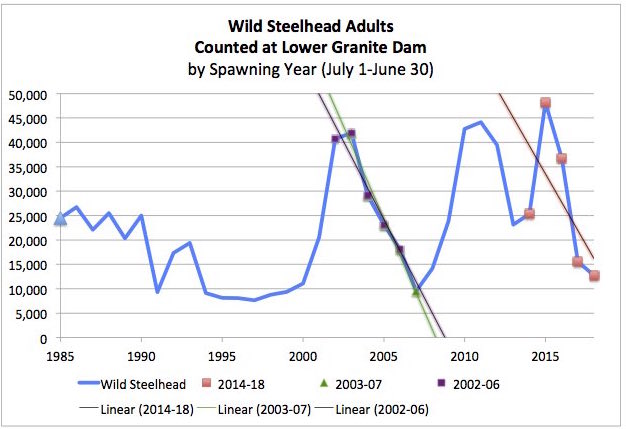forum
library
tutorial
contact

Another Rough Year Predicted
for Salmon, Steelhead
by K.C. Mehaffey
NW Fishletter, April 2, 2018
|
the film forum library tutorial contact |

|
Another Rough Year Predicted
by K.C. Mehaffey
|
 Washington, Idaho and NOAA Fisheries fish managers expect another year of poor salmon and steelhead returns in the Columbia and Snake rivers, although most species should fare somewhat better in 2018 compared with last year's low returns.
Washington, Idaho and NOAA Fisheries fish managers expect another year of poor salmon and steelhead returns in the Columbia and Snake rivers, although most species should fare somewhat better in 2018 compared with last year's low returns.
If predictions are accurate, overall, the Columbia River will host fewer adults returning compared to 2017, but the Snake River and Columbia above Bonneville Dam will record slightly more.
State and federal officials presented these forecasts on March 14 to the Northwest Power and Conservation Council. In all, some 1.1 million salmon and steelhead are expected to return to the Columbia River, including 904,000 predicted to pass over Bonneville Dam.
That compares with 1.2 million returning to the Columbia River last year, with 856,000 passing Bonneville Dam. In the Snake River at Lower Granite Dam, managers are expecting more than 180,400 salmon and steelhead, up from the 128,837 returning last year.
Dan Rawding, Washington Department of Fish and Wildlife's Columbia River policy and science coordinator, said there were good returns of fall Chinook in the late 1980s, and again in 2003 and 2004, and 2012 and 2013.
Now, he said, "We're on a downward trend for fall Chinook."
This year's forecasts would bring 356,600 to the Columbia River, compared with last year's return of 475,900 adults. In the Snake River, fall Chinook numbers would drop to 18,126 adults this year, compared with 24,780 last year. "We're in our fourth year of being down for fall Chinook," Paul Kline, assistant chief of fisheries for the Idaho Department of Fish and Game, told the Council.
The fish managers, however, raised more concerns about summer steelhead, although numbers are predicted to climb after last year's extremely low run.
Rawding said that last year, 116,841 summer steelhead crossed Bonneville Dam between April and October--the lowest return in 25 years, and one-third of the 10-year average.
This year, those numbers are forecast to jump to 190,350. In the Snake River, 69,568 summer steelhead returned, including both hatchery- and natural-origin fish, Kline said, adding, "Summer steelhead ... was one of the worst on record." This year, the forecast is for 96,080 returning adults, he said.
Rawding said the effects of the so-called Blob--a high-pressure ridge that sat off the coast of Washington and Oregon throughout 2014 and 2015--had the biggest impact on steelhead smolts headed out to sea those years, and those are the fish now returning as adults. Last year, fish agencies from Washington, Oregon and Idaho worked together to try to reduce impacts from recreational fishing--especially on Idaho's wild B-run, a larger and later-returning steelhead that returns mostly to the Clearwater and Salmon river drainages.
Last year's fishing restrictions included reduced limits on hatchery steelhead, rolling fishing closures in the main-stem Columbia, catch-and-release only requirements in the Snake, and no steelhead fishing in the upper Columbia, Rawding said. "We're looking at a much better return in 2018," he said, but "not quite back to where we were in the 20-year average." Kline said forecasters are predicting some 2,380 wild B-run fish to return this year.
Brian Burke, fishery biologist at NOAA's Northwest Fisheries Science Center, told the Council he expects it will take another year or two before salmon returns are back to normal, even after two winters of La Niña conditions.
"The Blob and El Niño were record setting, and had really big impacts," he said. Also, he said, La Niña is now diminishing, and more neutral sea-surface temperatures have returned. "We do expect a little more time before something like salmon can get back to normal conditions," he said.
Burke said forecasts are based on different juvenile salmon and ecosystem surveys in the ocean. Rawding said spring Chinook tend to be the most difficult to forecast. Generally, the forecasts are within 25 percent about half the time for spring Chinook, and about two-thirds of the time for other species, he said, adding, "When we miss, we often miss big."
learn more on topics covered in the film
see the video
read the script
learn the songs
discussion forum
